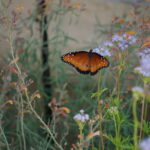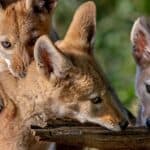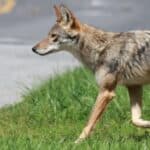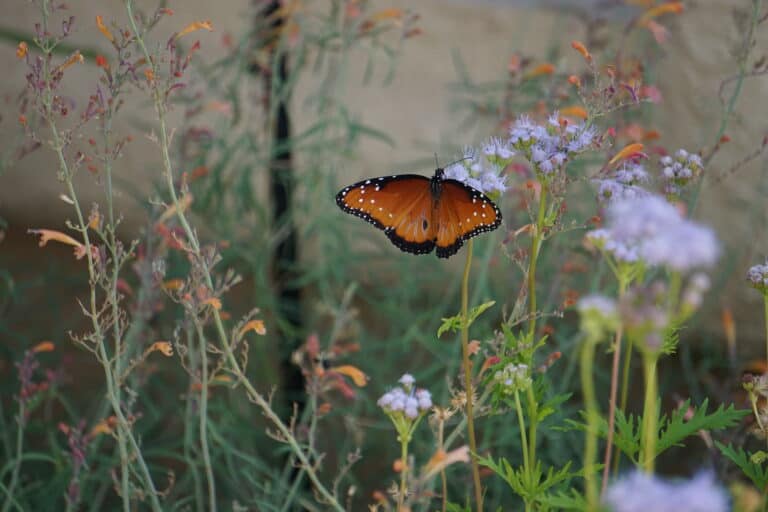Notes From The Field Blog interview by Camilla Fox, Founder & Executive Director, with Mark Surls, Wildlife Advocate & Photographer
Camilla: Thank you for your time, Mark, and for all your contributions to Project Coyote and our shared efforts to protect North America’s most persecuted carnivores. Can you share more about your initial interest in our organization and your current involvement as a #CaptureCoexistence Contributor?
Mark: Thank you, Camilla. For years, I had enjoyed the chance encounter with coyotes while viewing and photographing other wildlife. It was typically the highlight of my outing. In 2022, I made the decision to focus the majority of my efforts on our wild song dogs. During an outing to one of my favorite local spots, I met a fellow coyote enthusiast and friend of yours who suggested I reach out. It has proved to be a great lesson in listening, being open to suggestions and saying yes to opportunities. The timing couldn’t have been better too. The #CaptureCoexistence Campaign was about to launch, and I was able to contribute alongside so many incredible photographers in the continuing effort to end inhumane wildlife killing contests.
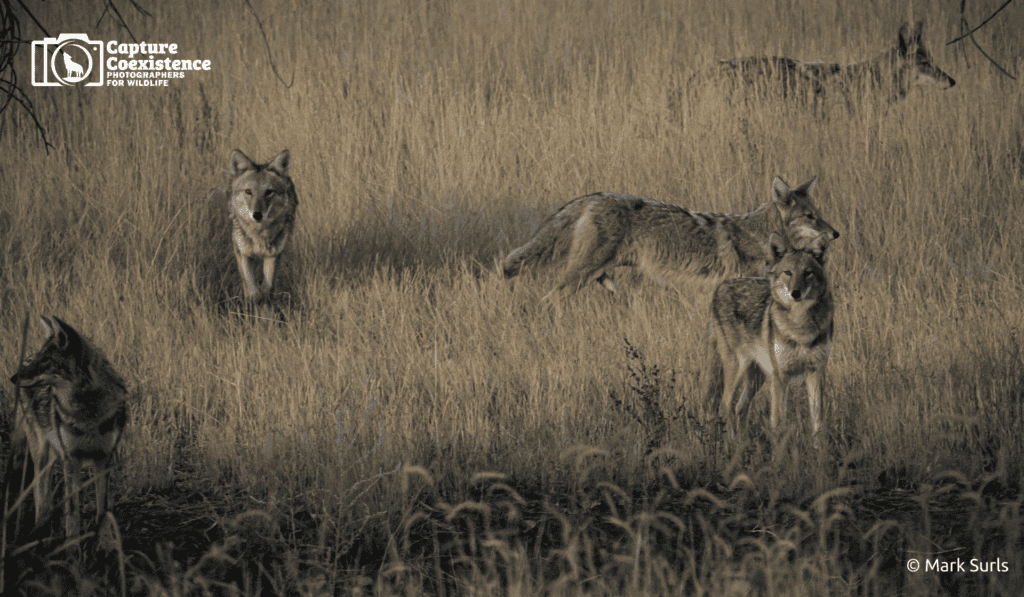
Photo by Mark Surls, #CaptureCoexistence Contributor
Camilla: As a Colorado resident, you’ve been involved in several campaigns to protect wild carnivores in your state, including a measure successfully passed by voters that mandates wolf recovery (Prop 114) and more recently a new initiative (CATS) to protect wild cats from trophy hunting and trapping. Can you tell us more about your involvement with both and what’s ahead for the CATS initiative?
Mark: Colorado has entered a pivotal moment in its history. Much of the public and the leadership of the state has said that we want new policies and ideologies around our wild neighbors that share this beautiful state with us. The wolf reintroduction campaign was a driving force in this change and whether people are for or against them, everyone should be thankful for this issue, sparking dialogue on how we want wildlife management to look like from here forward. Personally, I only participated as a concerned citizen, voicing my reasons why I think wolves on the landscape are a net benefit. However, getting involved in the process and meeting like-minded people who want to see Colorado as a beacon of what coexistence with all wildlife can look like led me to CATs. Cats Aren’t Trophies is a grassroots effort to end the inhumane, unethical and unsporting trophy hunting of mountain lions and trapping of bobcats. After joining the group in its early stages, I learned of the cruel use of hunting with hounds to tree a lion and then shoot the corner cat out of the tree. Not only are the methods unjustified, over 40% of the lions killed are female and they spend the vast majority of their adult lives either pregnant or raising young. This is unacceptable to me and I was soon consumed with all things CATs. I led the early efforts for outreach and now I am transitioning to volunteer coordinator for all of our signature gatherers. It is going to take a statewide effort to capture the 125,000 signatures needed to get this on the ballot and any registered Colorado voter can help us in this. We are also going to have a special 1,000 signature club with swag for anyone reaching that goal! You can find more information on the initiative and sign up to volunteer at www.catsarenttrophies.org.
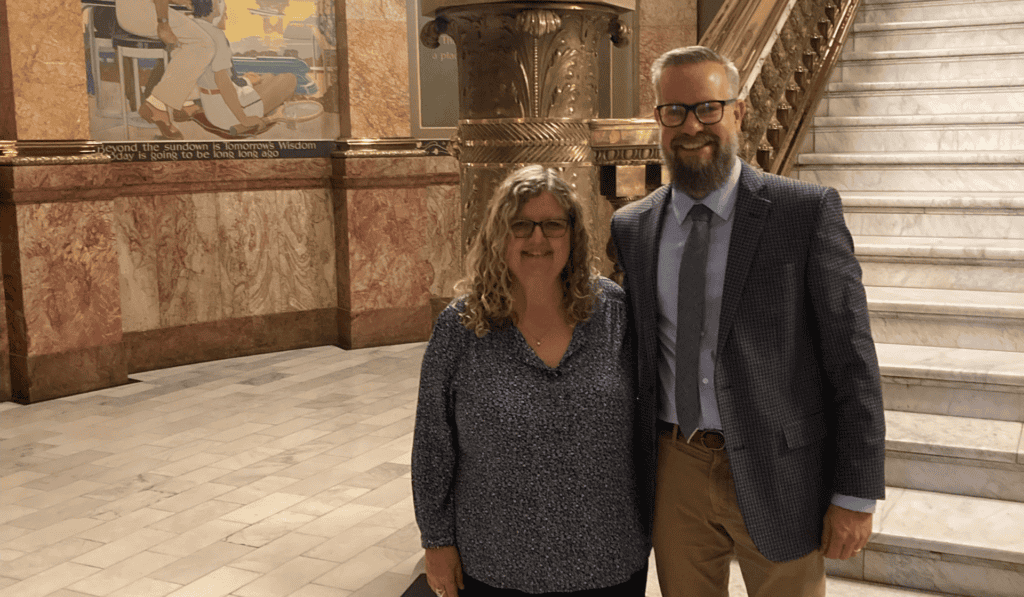
Mark Surls (registered agent for the CATs ballot initiative) at the Colorado State Capitol with Carol Monaco (co-agent for the CATs ballot initiative)
Camilla: When I had the pleasure of recently meeting you in person, you shared with me your work to address the issue of coyotes suffering from mange in the Arsenal National Wildlife Refuge – a place where you have been documenting the fascinating lives of individual coyotes and their family groups. Can you share more about what you’re doing to address this critical issue?
Mark: First, it was such a pleasure to meet in person. The Rocky Mountain Arsenal Wildlife Refuge is a unique gift that provides opportunities to see wildlife as iconic and imposing as the American bison and as fragile as the black-footed ferret, just outside a major urban center. Unfortunately, it has challenges facing the wildlife that inhabits it. Pollutants from industry in the area and impacts from its original use as a chemical warfare manufacturing site have lasting effects in its soil and water. One of the consequences has been mange in coyotes, sometimes leaving them completely hairless. But it also has a leadership team that understands the value of wildlife and the responsibility to correct the wrongs done by humans. Leadership, Prairie Protection Colorado (my partner in this effort) and I are in the early stages of developing a treatment strategy that could set a precedent in how the federal government treats animals suffering from mange.
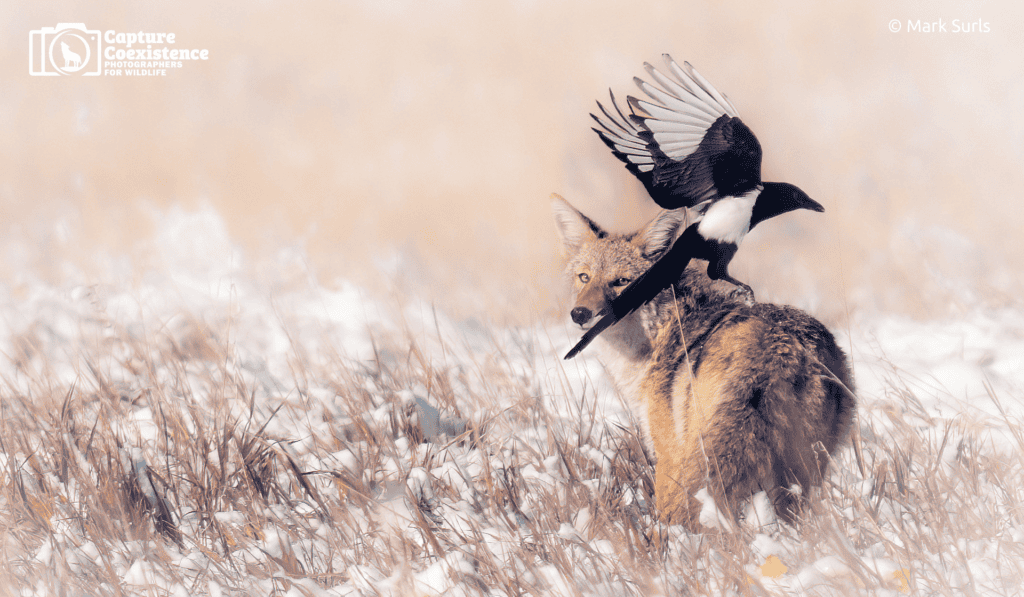
Photo by Mark Surls, #CaptureCoexistence Contributor
Camilla: You recently helped convince a major outdoor retailer to stop using second generation anticoagulant rodenticides – such an amazing achievement! Please tell us more about your efforts to accomplish this, how you went about doing this, and the dangers rodenticides posed to wildlife/non- target animals?
Mark: I’ve had the pleasure of working for this company for the past 9 years. When I learned about the detrimental impacts of second-generation anticoagulant rodenticides (SGARs), it opened my eyes and lowered my gaze to look for feed stations using them. SGARs can cause compromised immune systems, infertility and death in raptors and carnivorous mammals who consumed the poisoned rodents. The main barrier I have found is the public is generally not aware of the downstream impact of these poisons, so when I approached leadership about their use, I was met with shock and immediate support to find alternatives. So far, we have committed the pest control company that we are under contract with to stop using any poison that is illegal in California. Furthermore, we are exploring the use of a brand new contraceptive that does not bioaccumulate, protecting all predatory animals, the soil and water.
I encourage anyone to look around at your work, read the labels on the feed stations and start the conversation. Reach out to leadership and educate every step of the way. The more people that understand the impact of poisons, the more likely you will see a positive outcome and hopefully encourage others to be more attentive to the problem throughout their lives. Before you do have the conversation, visit www.raptorsarethesolution.org for a wealth of information and printable pamphlets to present.
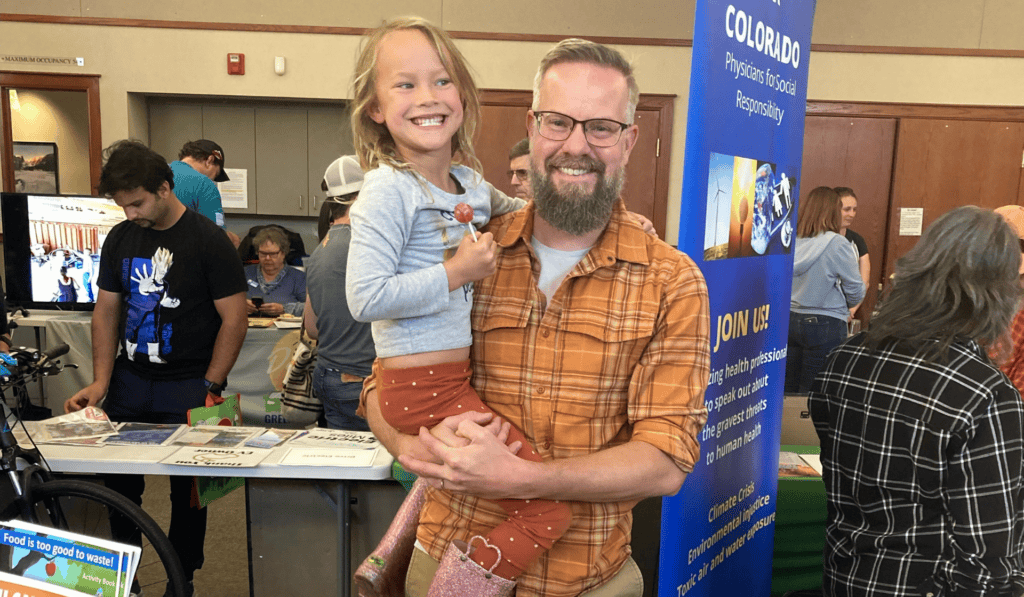
Mark Surls and his daughter, Sofia, while tabling to talk about SGARs and promote his new book
Camilla: I was thrilled to write an endorsement blurb for your recently published book Coyote Conversations. Can you share more about what inspired you to create this beautiful book and how people can learn more about it?
Mark: And what an honor it is to have your endorsement! I had a vision to create a book built on compassion and provide a unique experience for the reader. I wanted something as beautiful as a coffee table book, but also begged to be held. I wanted it to be approachable and to be able to share how coyote has impacted me. Each photo is paired with an original poem I wrote either about the experience or more existential questions or threats; sometimes written in my voice, sometimes the voice of coyote. The process forced me to spend more time with each photo and really reflect on why I was drawn to it and what it told me. For more information about the book and how to order it, please visit www.surlsart.com or find it on Amazon.
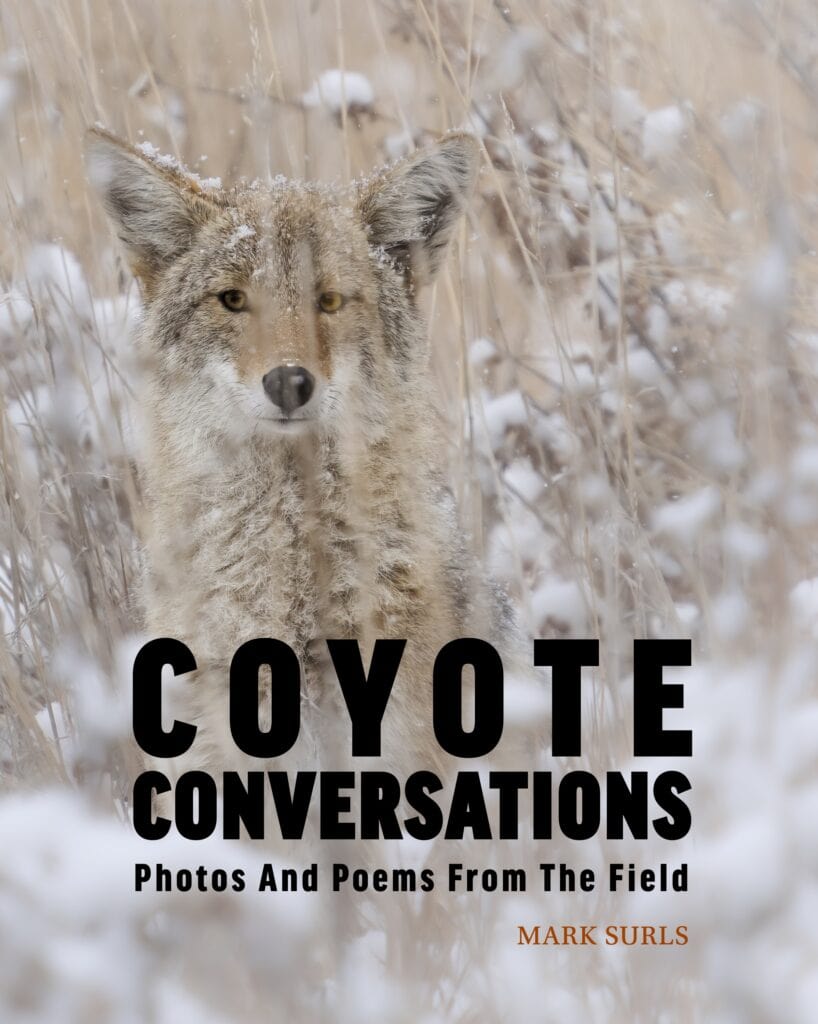
Book cover of Mark Surls’ new book “Coyote Conversations”
Camilla: You’ve done so much independently to advocate on behalf of wildlife. How did you get involved in wildlife advocacy and what would you suggest to others who want to help wildlife but are not sure how to engage?
Mark: This is my favorite question. While I’m proud of my individual accomplishments, I am more excited to inspire another person to take their first step into advocacy. But to answer your first question of how I started my work in wildlife advocacy, it began after a conversation with fellow photographer and wild horse advocate, Scott Wilson. Afterward, I realized that I was exploiting wildlife for personal gain, but I was not doing anything to protect the animals I love so dearly. Once I knew I had to do my part, opportunities to bring change were everywhere I looked. I encourage anyone to be open to new endeavors advocating for whatever you are most passionate about, find organizations that align with your belief system, see how your strengths fit with their needs and say yes, and keep saying yes!
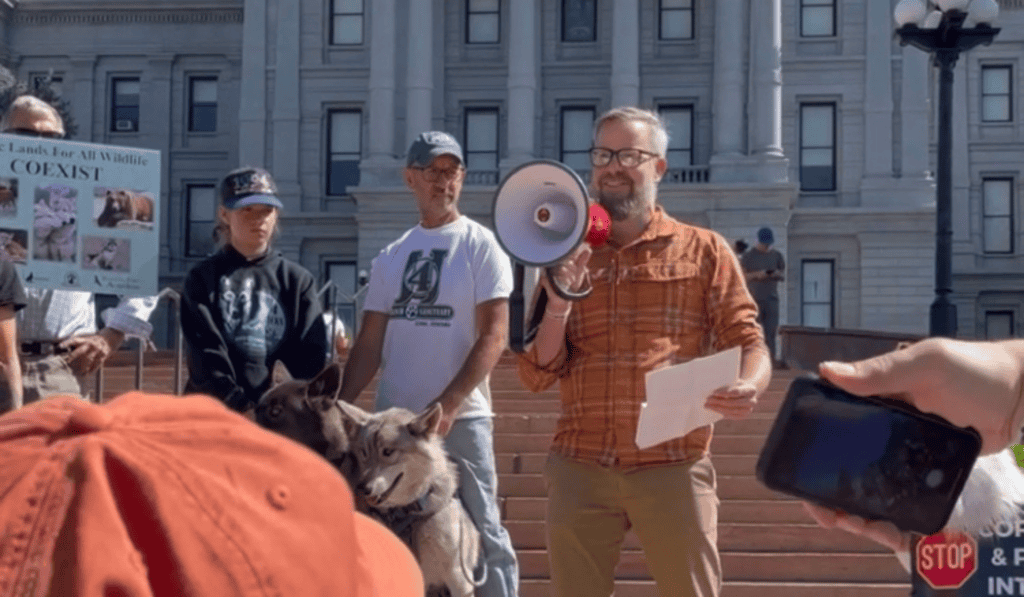
Mark Surls giving a speech at the rally for public lands in Denver
You can order Mark’s new book Coyote Conversations and learn more about his photography here.

